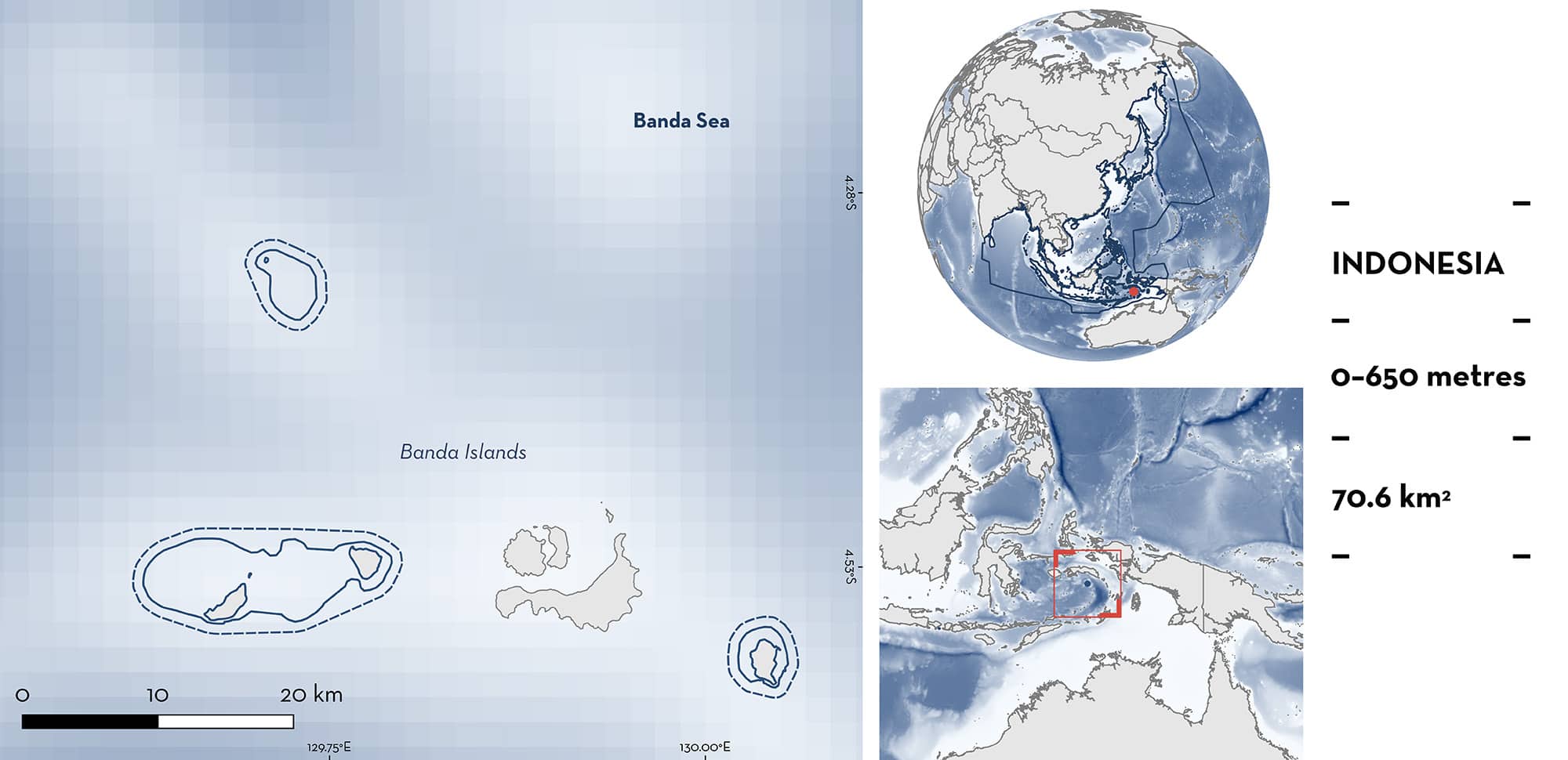ISRA FACTSHEETS
ISRA FACTSHEETS
ASIA REGION
Banda Islands
Summary
Banda Islands is located in the Indonesian Banda Sea. The area includes four islands: Hatta, Rhun, Ai, and Suanggi Islands and is characterised by the presence of coral reefs and pinnacles near the islands. The area overlaps with the Perairan Kepulauan Banda Key Biodiversity Area. Within the area there are: threatened species and undefined aggregations (Scalloped Hammerhead Sphyrna lewini).
Download factsheet
Banda Islands
DESCRIPTION OF HABITAT
Banda Islands is located in the Banda Sea, in the Maluku province of Indonesia. The area includes four islands: Hatta, Rhun, Ai, and Suanggi Islands (Mukharror & Ibrahim 2022). It is characterised by the presence of coral reefs and pinnacles near the islands and an extended continental shelf.
The Banda Sea is highly influenced by monsoon winds (Moore et al. 2003) The southeast monsoon (June to September) produces lower sea surface temperatures and large-scale upwelling on the eastern side of the sea, where the Banda Islands is located, while the northwest monsoon (December to March) brings higher temperatures and a depression of the thermocline (Moore et al. 2003; Iskandar 2010).
The area overlaps with the Perairan Kepulauan Banda Key Biodiversity Area (KBA 2024).
This Important Shark and Ray Area is pelagic and is delineated from inshore and surface waters (0 m) to 650 m based on the bathymetry of the area.
CRITERION A
VULNERABILITY
One Qualifying Species within the area is considered threatened with extinction according to the IUCN Red List of Threatened Species. The Scalloped Hammerhead is assessed as Critically Endangered (Rigby et al. 2019).
CRITERION C
SUB-CRITERION C5 – UNDEFINED AGGREGATIONS
Banda Islands is an important area for undefined aggregations of one shark species.
In 2015, videos began circulating online revealing aggregations of Scalloped Hammerheads in the Banda Sea, including at Banda Islands (J Hennicke pers. obs. 2016). Since then, diving activities started operating in the area to observe these aggregations (AB Sianipar & J Hennicke pers. obs. 2023). Aggregations of between 80–200 Scalloped Hammerheads are regularly observed each year at Hatta and Suanggi, while in Rhun and Ai aggregations are composed by 10–35 individuals (AB Sianipar & J Hennicke pers. obs. 2023; Guido Weissenfeld – Blue Motion Dive pers. comm. 2024). Smaller aggregations are observed year-round but larger aggregations which diving operators focus on are only seen from mid-September to early December (Guido Weissenfeld – Blue Motion Dive pers. comm. 2024). The presence of these aggregations was confirmed during dives undertaken to explore the behaviour and movement of Scalloped Hammerheads in four islands within the Banda Sea, including Suanggi Island in October 2021 (Mukharror & Ibrahim 2022). In addition, Scalloped Hammerhead aggregations were reported in each of 13 dives around Hatta Island between October 2022 and October 2023 (10–35 individuals), confirming their regular presence in the area (Konservasi Indonesia unpubl. data 2023). More information is needed to understand the nature and function of these aggregations.
Download factsheet
SUBMIT A REQUEST
ISRA SPATIAL LAYER REQUEST
To make a request to download the ISRA Layer in either a GIS compatible Shapefile (.shp) or Google Earth compatible Keyhole Markup Language Zipped file (.kmz) please complete the following form. We will review your request and send the download details to you. We will endeavor to send you the requested files as soon as we can. However, please note that this is not an automated process, and before requests are responded to, they undergo internal review and authorization. As such, requests normally take 5–10 working days to process.
Should you have questions about the data or process, please do not hesitate to contact us.


